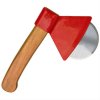We all know what the word “slice” means. It should also be apparent that use of “slicey” is subjective. We see it thrown around here, as well as references to blades being thin or thick behind the edge. There doesn’t seem to be much value behind this practice. Often times, it feels like something people say for the sake of saying it.
So, BF, let’s here it. When *you* say a blade is “slicey”, what do you really mean by that? Are you talking about food prep application? Are you talking cardboard? Are you attached to a behind the edge measurement threshold, rather than application? Lay it out, in detail.
So, BF, let’s here it. When *you* say a blade is “slicey”, what do you really mean by that? Are you talking about food prep application? Are you talking cardboard? Are you attached to a behind the edge measurement threshold, rather than application? Lay it out, in detail.


